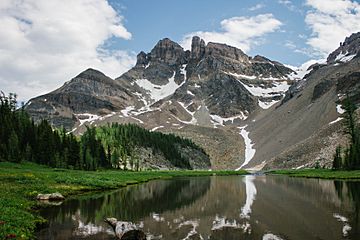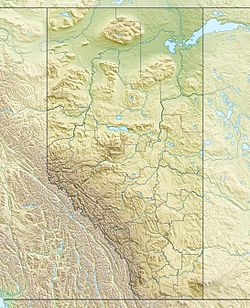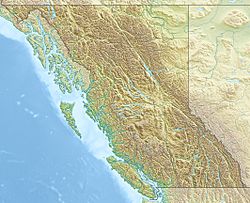The Towers (Canada) facts for kids
Quick facts for kids The Towers |
|
|---|---|

The Towers seen from a pond near Gog Lake
|
|
| Highest point | |
| Elevation | 2,842 m (9,324 ft) |
| Prominence | 189 m (620 ft) |
| Listing | Mountains of Alberta Mountains of British Columbia |
| Geography | |
| Country | Canada |
| Parent range | Canadian Rockies |
| Topo map | NTS 82J/13 Mount Assiniboine |
| Climbing | |
| First ascent | 1916 Interprovincial Boundary Commission |
The Towers is a mountain that stands 2,842-metre (9,324-foot) tall. It is located right on the border between the Canadian provinces of Alberta and British Columbia. This mountain is also part of the Continental Divide, which is like a giant line across North America where rivers on one side flow to the Pacific Ocean and rivers on the other side flow to the Atlantic or Arctic Oceans.
The Towers is special because it sits between two important parks: Banff National Park in Alberta and Mount Assiniboine Provincial Park in British Columbia. A man named Arthur O. Wheeler gave the mountain its name in 1917. The closest taller mountain to The Towers is Mount Magog, which is about 2.5 km (1.6 mi) to its west.
How The Towers Was Formed: Geology
The Towers mountain is made up of sedimentary rock. This type of rock forms when layers of sand, mud, and tiny bits of plants and animals settle at the bottom of ancient seas over millions of years. These layers get pressed together and turn into rock.
The rocks in The Towers were formed during different time periods, from the Precambrian era (which was billions of years ago) all the way to the Jurassic period (the time of dinosaurs!). Later, during a huge event called the Laramide orogeny, these rocks were pushed up and over younger rocks. This process created the tall mountains we see today, including The Towers.
Weather at The Towers: Climate
The climate at The Towers is known as a subarctic climate. This means the area has very cold and snowy winters. Summers, on the other hand, are usually mild.
During winter, temperatures can drop below -20°C (that's -4°F!). When you add in the wind, it can feel even colder, sometimes below -30°C (-22°F). This type of climate is common in northern parts of the world, like much of Canada.



